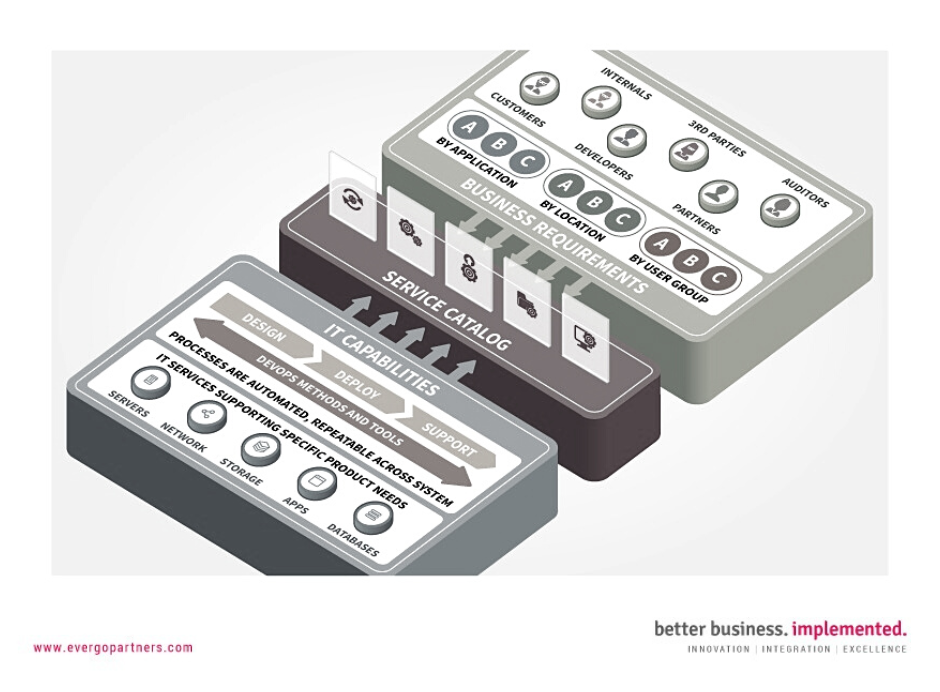Introduction
ITIL defines Service Catalogue as a database or structured document with information about all live services, including those available for deployment. The Service Catalogue is the only part of the Service Portfolio published to Customers, and is used to support the sale and delivery of IT Services. The Service Catalogue includes information about deliverables, prices, contact points, ordering and request processes.
Although the topic can’t be considered a new one as many companies and institutions has already implemented Service Catalogue still many implementations don’t deliver what are supposed to deliver. A that is really bad as successfully implemented and managed Service Catalogue offers wide array of benefits both for customers and IT. It’s also a cornerstone for other processes like Request Fulfillment, Demand Management, Capacity Management, Incident Management, Change Management, Knowledge Management and others.
In this material we would like to share what we (at EvergoPartners) think is important while implementing and managing Service Catalogue.
Do not allow vendors to drive your project
We believe that tooling is important part of IT Service Management especially when it’s used to present and sell your services to your customers. Yes, you should look at this in such a way even if they are internal customers!
There are many vendors offering ITSM platforms including Service Catalogue module on the market. Many of them offer also some consultancy and advice on best practices how to implement Service Catalogue Management. Sometimes there is a temptation to take it as it’s and rely solely on the vendor’s advice. Well these are best practices after all that were developed based on many implementations in multiple organizations.
We strongly recommend not to do it or at least without thorough internal discussion. You should plan enough time to allow yourself to discuss the Service Catalogue design with all relevant stakeholders within your organization. This is you and your colleagues from your company that know what are your business plans and business priorities and what IT Services you need to be able to achieve them. You know your organizational structure and organizational culture better than the vendor.
Take your time and be sure that Service Catalogue is what your organization needs. Remember that once it’s implemented it’s not that easy to change it.
Apply Customer – Centric approach
One of the common mistakes in Service Catalogue projects is applying Technology – Centric approach. It’s natural tendency within IT to take the approach as many IT organizations are organized around technology domains. The result usually is that although such Service Catalogue is well understandable by IT it’s not intuitive for the customers at all what can lead to project failure.
Instead we strongly believe in Customer – Centric approach when Service Catalogue is designed together with the business stakeholders. The Service Catalogue is not for only for IT but mainly for customers. Therefore, it’s of critical importance to understand their needs and their perspective.
Good advice is to carry out workshops with representatives of your business functions at the very beginning of the project and agree on Service Structure including naming conventions of Business Services, service description and how the IT categorized in groups (the taxonomy).
The effort to understand business and build the relationship might be quite significant but will pay off in the future for sure.
Make it attractive and interactive
The Service Catalogue is IT window to its customers. It’s more than obvious you need to make it attractive to attract them and keep using it. That’s one of the points when knowledge of your customers pays off.
Regardless of the tool you use to present your service catalogue it’s important to tailor the content of Service Catalogue to the expectations of your customers. Common mistake is to put too much information about the service that is irrelevant for customers like underlying technology and service components used. Focus rather on what is important and understandable to the business. Also, avoid technical jargon as it may confuse them. However please note that in some cases they might be interested in some more technical details, for example engineering departments. Tailor the content accordingly.
The other important thing to is to make the Service Catalogue interactive. Instead of publishing static Service Catalogue consider to integrate some other features that will make it useful for customers. Many ITSM solutions providing integrated toolset will give you a helpful hand here.
Some examples are:
- Provide possibility to initiate and check status of the service request directly from the Service Catalogue rather making customer to use another tool;
- Allow customers to provide feedback. But remember to act on it;
- Provide information about ongoing incidents planned downtime related to the Services;
- Integrate with Knowledge Management allowing to access quickly Knowledge Articles for the Services;
- Inform about any relevant changes to the Service Catalogue;
- All those features will help you to keep your customers coming back.
Keep it up to date
Obsolete and hence misleading information on the Service Catalogue may discourage customers effectively. Unfortunately, what we (at EvergoPartners) noticed is that it happens sometime that once implemented that Service Catalogue is simply forgotten and gather dust over time.
In order to avoid such situation Service Catalogue Manager role needs to be established and assigned. The Service Catalogue Manager is responsible for maintaining the Service Catalogue, ensuring that all information within the Service Catalogue is accurate and up-to-date. In bigger companies the responsibility may be distributed among other roles like Service Owner or Service Manager for specific IT Services. However, it’s worth mentioning that Service Catalogue Manager should still be accountable for overall Service Catalogue design, consistency and completeness.
Integrate with CMDB
Having Service Catalogue design reflected in CMDB helps a lot when it comes other ITIL processes.
Well done mapping between Business Service, Supporting Services (also called Technical Service) and service components improves a lot visibility and transparency of IT Services. Below are some of the examples:
- Incident Management – helps to quickly identify and diagnose incidents as well as decide on potentials impact and urgency;
- Change Management – helps to identify easily what Business Services might be impacted due to planned changes and communicate it to relevant stakeholders;
- Problem Management – thanks to the relationships makes the root cause analysis much more mature;
- Service Level Management – allows to focus on the Business Service quality rather than on the technical components that are irrelevant for Customers.

It’s been our (EvergoPartners) observations that some companies miss benefits of Service Catalogue due to the fact they didn’t devote enough time and effort to prepare to its implementation assuming that new ITSM toolset would solve all the problems. No, it’s not so easy and will not happen overnight but it’s worth investing your time and effort in well-structured design and planning phase and we are here to help you :-).




